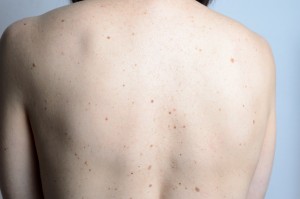 Melanoma is one of the deadliest forms of skin cancer and catching it early is the best option when it comes to diagnosis and treatment options. “I encourage patients to look at their skin regularly,” says Dr. Adam Mamelak, board certified dermatologist and skin cancer expert in Austin, Texas. “Checking your spots is not difficult, and there’s a few basic strategies patients can use to detect suspicious and worrisome moles.”
Melanoma is one of the deadliest forms of skin cancer and catching it early is the best option when it comes to diagnosis and treatment options. “I encourage patients to look at their skin regularly,” says Dr. Adam Mamelak, board certified dermatologist and skin cancer expert in Austin, Texas. “Checking your spots is not difficult, and there’s a few basic strategies patients can use to detect suspicious and worrisome moles.”
The Ugly Duckling Test
The Ugly Duckling Test is based on the fact that melanoma-skin cancer spots look or feel different from a patient’s other moles, at any given time. These outliers will often have a different size or shape than other moles, itch, bleed, or generally refuse to heal. If the patient has no other moles on the skin, then any spot is also an outliers and should be watched carefully until it becomes clear that they either are or aren’t symptomatic.
Know your ABCDEs
This self-test requires that you know your skin well, but can be very effective at catching early warning signs. Each letter stands for a different point to look for during monthly skin checks:
- Asymmetry – If you were to draw a line through a benign mole, both sides would match evenly. If you cannot do this, the moles is asymmetric and should be checked.
- Border – The border of a benign moles will be smooth and even. If the border is faded, uneven, notched, or scalloped, the moles should be checked.
- Color – While benign moles are a single color, often brown, melanoma can appear with a variety of colors in a single mole – browns, tans, blacks, and in some cases even red, blue, or white.
- Diameter – Benign moles are often smaller than malignant ones. Often, spots caused by melanoma will be larger than a pencil eraser, though the may be smaller at first if they’re noticed early.
- Evolving – Benign moles stay static over time. If you notice a spot changing in size, shape, elevation, color, or exhibiting a new symptom such as burning, itching, or bleeding, seek medical treatment immediately.
Contact Us
Dr. Mamelak treats skin diseases and skin cancer patients at Sanova Dermatology and The Austin Mohs Surgery Center. For more information about melanoma or to speak with our professional dermatologist about skin health or about any moles you’re concerned about, please contact us.
Join Us
